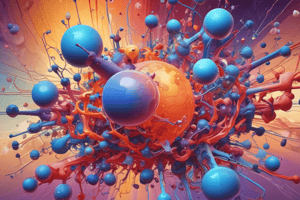Podcast
Questions and Answers
Which state of matter has particles that are widely spaced out and move rapidly?
Which state of matter has particles that are widely spaced out and move rapidly?
- Solid
- Liquid
- Gas (correct)
- Bose-Einstein condensate
What is the fundamental characteristic that defines matter?
What is the fundamental characteristic that defines matter?
- It can be found only in solid state
- It is always in a gaseous state
- It has a specific shape
- It occupies space and has mass (correct)
Which state of matter is a highly energetic mixture of positive ions, electrons, and neutral atoms?
Which state of matter is a highly energetic mixture of positive ions, electrons, and neutral atoms?
- Liquid
- Plasma (correct)
- Bose-Einstein condensate
- Solid
What is the chemical property that describes a substance's ability to accept a proton?
What is the chemical property that describes a substance's ability to accept a proton?
What is the process of separating a mixture of substances based on their differences in physical properties?
What is the process of separating a mixture of substances based on their differences in physical properties?
At what temperature does a Bose-Einstein condensate occur?
At what temperature does a Bose-Einstein condensate occur?
What is the primary difference between reactivity and solubility?
What is the primary difference between reactivity and solubility?
Which separation technique is based on differences in electrical charge?
Which separation technique is based on differences in electrical charge?
What is the primary characteristic that distinguishes a mixture from a pure substance?
What is the primary characteristic that distinguishes a mixture from a pure substance?
Which of the following physical properties is NOT observable without changing the substance's chemical composition?
Which of the following physical properties is NOT observable without changing the substance's chemical composition?
What is the term for the three-dimensional form of an object?
What is the term for the three-dimensional form of an object?
Which type of mixture is characterized by a uniform composition throughout?
Which type of mixture is characterized by a uniform composition throughout?
Flashcards are hidden until you start studying
Study Notes
Matter in Our Surroundings: Understanding States, Properties, and Separation Techniques
Matter is anything that occupies space and has mass. It is the fundamental substance that makes up our world, from the air we breathe to the materials that build our homes. Understanding the properties and behavior of matter is crucial in various fields, from chemistry to physics.
States of Matter
Matter exists in five main states: solid, liquid, gas, plasma, and Bose-Einstein condensate. Solids, such as ice or metals, are composed of particles that are tightly packed and move very little. Liquids, like water or mercury, have particles that can move over and between one another. Gases, like air or steam, have particles that are widely spaced out and move rapidly. Plasma is a highly energetic mixture of positive ions, electrons, and neutral atoms, often found in high-temperature environments like the sun. Bose-Einstein condensate is a state of matter that occurs at very low temperatures, where atoms are in a coherent quantum state, similar to a superfluid.
Chemical Properties
Chemical properties of matter describe how substances interact with other substances or energy. These properties include reactivity, acidity, basicity, and solubility. For example, an acid is a substance that can donate a proton (H+) to another substance, while a base can accept a proton. Reactivity refers to the ability of a substance to react with other substances, while solubility describes how easily a substance can dissolve in a given solvent.
Separation Techniques
Various techniques are used to separate matter into its constituent parts. These include filtration, centrifugation, distillation, chromatography, and electrophoresis. Filtration separates matter based on particle size, while centrifugation uses centrifugal force. Distillation separates matter based on differences in boiling points, chromatography separates based on differences in affinity for a particular medium, and electrophoresis separates based on differences in electrical charge.
Physical Properties
Physical properties of matter include mass, volume, shape, color, texture, and state. These properties are observable without changing the substance's chemical composition. For example, the mass of an object is determined by its weight, while the volume is the amount of space it occupies. Shape is the three-dimensional form of an object, and texture refers to its tactile properties, such as smoothness or roughness.
Mixtures
A mixture is a combination of two or more substances that can be physically separated without changing their chemical properties. Examples of mixtures include air (a mixture of gases like nitrogen, oxygen, and carbon dioxide), soil (a mixture of minerals, water, and organic matter), and saltwater (a mixture of salt and water). Mixtures can be homogeneous (uniform in composition throughout) or heterogeneous (not uniform).
Understanding the properties and behavior of matter is essential for various applications, from designing new materials to understanding environmental processes. By studying matter, we can gain insights into the fundamental nature of our universe.
Studying That Suits You
Use AI to generate personalized quizzes and flashcards to suit your learning preferences.




